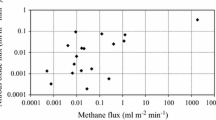Abstract
A micrometeorological mass balance technique was used to quantify the N2O flux from a solid dairy manure pile under field conditions. Flux was determined using time-averaged measurements of wind speed, and nitrous oxide concentration using a tunable diode laser trace gas analyzer. A total of 66 hourly flux averages were collected and values were never lower than 200 ng N2O-N m−2 s−1. The mean hourly N2O flux was 4865 ng N2O-N m−2 s−1 (0.42 g N m−2 day−1), which is of the same order of magnitude, albeit higher, as previously observed for a similar solid pig manure storage.
Similar content being viewed by others
References
Berges MG & Crutzen PJ (1996) Estimates of global N2O emissions from cattle, pig and chicken manure, including a discussion of CH4 emissions. J Atmos Chem 24: 241–269
Boxberger J, Amon B & Pollinger A (1997) Flüssige und gasförmige emissionen während der Festmistlagerung undkompostierung. “Lysimeter und nachhaltige Landnutzung”, BAL Gumpenstein 7: 7–9
Brown HA, Wagner-Riddle C and Thurtell GW (2000) Nitrous oxide flux from solid dairy manure in storage as affected by water content and redox potential. J Environ Qual 29: 630–638
Burton CH, Sneath RW & Farrent JW (1993) Emissions of nitrogen oxide gases during aerobic treatment of animal slurries. Biores Tech 45: 233–235
Flessa H, Dorsch P, König H & Bouwman AF (1996) Influence of cattle wastes on nitrous oxide and methane fluxes in pasture land. J Environ Qual 25: 1366–1370
Fowler D & Duyzer JH (1989) Micrometeorological techniques for the measurement of trace gas exchange. In: Andrae MO & Schimel DS (eds) Exchange of Trace Gases between Terrestrial Ecosystems and the Atmosphere, pp 189–207. Chichester, John Wiley & Sons
Granli T & Bøckman OC (1994) Nitrous oxide from agriculture. Norw J Agric Sci Suppl No. 12: 1–128
Groenestein CM & Van Faassen HG (1996) Volatilization of ammonia, nitrous oxide and nitric oxide in deep-litter systems for fattening pigs. J Agric Eng Res 65: 269–274
Hartung J & Phillips VR (1994) Control of gaseous emissions from livestock buildings and manure stores. J Agric Eng Res 57: 173–189
Huther L, Schuchardt F, Willke T, Ahlgrimm HJ & Vorlop KD (1995) Methane and nitrous oxide emissions during storage and composting of cattle manure — a study using gas chromatography. Translated in Silsoe-Res-Inst (1997), No. 62, VDI Berichte 1211: 219–222
IPCC (1996) Climate Change 1995. Impacts, adaptations and mitigation of climate change: scientific-technical analysis. Contribution of working group II to the second assessment report of the IPCC. Watson RT, Marufu CZ & Moss RH (eds) Cambridge University Press, Cambridge, UK
Kaharabata SK, Schuepp PH & Desjardins RL (1998) Methane emissions from aboveground open manure slurry tanks. Global Biogeochem Cycles 12: 545–554
Khan RZ, Muller C & Sommer, SG (1997) Micrometeorological mass balance technique for measuring CH4 emission from stored cattle slurry. Biol Fertil Soils 24: 442–444
Mosier A, Kroeze C, Nevison C, Oenema O, Seitzinger S & van Cleemput, O (1998) Closing the global N2O budget: nitrous oxide emissions through the agricultural nitrogen cycle. OECD/IPCC/IEA phase II development of IPCC guidelines for national greenhouse gas inventory methodology. Nutr Cycl Agroecosys 52: 225–248
Oenema O, Velthof GL & Bussink DW (1993) Emissions of ammonia, nitrous oxide and methane from cattle slurry. In: Oremland RS (ed) Biogeochemistry of Global Change: Radiatively Active Trace Gases, pp 419–432. Chapman & Hall Inc., London
Ryden JC & McNeill JE (1984) Application of the micrometeorological mass balance method to the determination of ammonia loss from a grazed sward. J Sci Food Agric 35: 1297–1310
Sibbesen E & Lind AM (1993) Loss of nitrous oxide from animal manure in dungheaps. Acta Agric Scand Sect B: Soil Plant Sci 43: 16–20
Wagner-Riddle C, Thurtell GW, Kidd GE, Beauchamp EG & Sweetman R (1997) Nitrous oxide emissions from agricultural fields over 28 months. Can J Soil Sci 77: 135–144
Wilson JD, Catchpoole VR, Denmead OT & Thurtell GW (1983) Verification of a simple micrometeorological method for estimating the rate of gaseous mass transfer from the ground to the atmosphere. Agric Met 29: 183–189
Author information
Authors and Affiliations
Corresponding author
Rights and permissions
About this article
Cite this article
Brown, H., Wagner-Riddle, C. & Thurtell, G. Nitrous oxide flux from a solid dairy manure pile measured using a micrometeorological mass balance method. Nutrient Cycling in Agroecosystems 62, 53–60 (2002). https://doi.org/10.1023/A:1015172816650
Issue Date:
DOI: https://doi.org/10.1023/A:1015172816650




